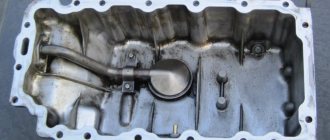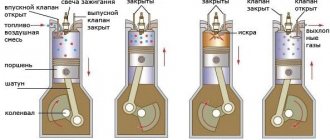Motor lubricant
The main task of the lubricant is to reduce friction of the metal parts of the engine. For this function to function properly, a certain engine oil temperature is required. Lubricants are developed taking this factor into account, which ensures stable engine operation.
What temperature should the lubricant be? You can answer the question by studying the same indicator of the cooling material. Engine oil is always 10 or 15 degrees hotter than the coolant. Its heat level of 105 °C is the maximum normal threshold.
When choosing suitable auto chemicals, you need to proceed from the car brand and the manufacturer’s recommendations. Then the product will maintain the optimal temperature when the engine is running. Also, the oil must have a certain level of the most important parameters: viscosity and lubrication.
oils
Russia is great - we have steep mountain serpentines, and long “thrusts” of the Trans-Urals, and flat highways as smooth as an arrow. In the north, due to severe frosts, drivers do not turn off the engines of their trucks at night and insulate them by throwing old quilted jackets over them. In the southern regions (and this summer in the middle zone), the sun heats the asphalt to the melting point, and the cooling system of the tractor pulling a truck loaded to the limit cannot cope with the thermal load, allowing the temperature indicator needle to enter the red zone of the scale. Motor oil often operates under the most extreme conditions, which leads to its rapid oxidation and a sharp reduction in service life. Alas, mechanics in most cases do not make allowances for the special operating conditions of the oil and do not shorten its service life. This is done partly out of ignorance, partly from the desire to save on buying 25–30 liters of oil. As a result, instead of the relatively small costs of changing the engine oil, the carrier may end up with a major engine overhaul! Let's look at the problem in detail.
Low operating temperature
The operating temperature in the crankcase should not be lower than normal. In most cases, the norm is above 90 degrees. If the temperature is low, the cooling system will lower it even more. This will entail ineffective operation of the entire unit: the parts will not expand enough, so there will not be the required gap between them.
Auto oil sensor
In addition, acids begin to form in the lubricant. In an insufficiently heated engine, moisture condenses, which enters the oil and mixes with combustion products, forming acids that destroy light metals. If the temperature in the mechanism is normal, this does not happen due to water evaporation.
This problem can be made worse if the lubricant is too thick to pass through the filtration system. The oil will partially pass through the bypass valve, which will accelerate wear on the operating parts. Fluid leaks may also occur. All this will adversely affect the operation of the engine.
Then in the heat...
As we have already mentioned, when the engine overheats, intensive oxidation of the additive package occurs in the engine oil and a sharp deterioration in its performance characteristics. For greater clarity, let’s imagine how, in a hot summer, a tractor is dragging a semi-trailer loaded to the limit up a mountain. The assault on the mountain lasts 30 minutes. During this time, the coolant temperature rises to 100 degrees, which is ten degrees more than the engine operating temperature. But since the internal combustion engine cooling system is filled with coolant with a boiling point of 110–115 degrees, the liquid does not boil. But at the same time, we note that the diesel engine overheats! Let's consider how oils of the same quality class, identical viscosity, for example, 10W-40, but different in base: mineral, semi-synthetic, fully synthetic, will behave in this situation.
According to the theory, which is confirmed by laboratory tests carried out in our research center, even such a short period of time when the oil is overheated significantly affects its service life.
Within thirty minutes, various fatty acids are formed in motor oil overheated by 10 degrees, and high-temperature soot, varnish, and coke are deposited, which have a negative effect on the additive package and the base for a long time. That is, just one short overheating of the engine and, accordingly, the oil reduces its service life. The question is how much?
Oil made with a fully synthetic base resists overheating best. The dependence of the change in the viscosity index of a fully synthetic oil on its temperature is much less pronounced than that of mineral and semi-synthetic oils. In other words, when synthetics overheat, there is no significant drop in viscosity. This is very important, especially in relation to diesel engines that have spent more than half of their service life. The fact is that in worn-out joints, for example, in crankshaft sliding bearings, the gap is increased. Oil diluted by high temperature, even with a working oil pump supplying the required pressure to the main line, is not able to create a reliable oil wedge, thanks to which the shaft “floats up”. That is, the oil must maintain viscosity even at high temperatures. Moreover, synthetic base oil resists oxidation much better and, accordingly, is less susceptible to aging and destruction. Let's add to this the undeniable advantages of synthetics, such as high detergent and dispersant properties (the ability of the oil to keep contaminants in suspension and not allow them to precipitate) due to which deposits do not accumulate in the engine, but merge with the waste. By the way, this is why non-drained residue and contaminants do not have a noticeable effect on fresh oil. And finally, the last thing: fully synthetic oil resists heating up to hundreds of degrees, practically without changing its properties. That is, there is no need to replace synthetics.
Product viscosity: which one is suitable?
During a cold start, the fluid must provide rapid lubrication of the mechanism parts, instantly passing through the system. The properties of the oil should be maintained in cold weather, but as the temperature rises, its viscosity drops. That is, you should not strive to purchase a universal product; it still will not be able to ensure normal operation of your engine every day throughout the year. There is also no need to look for an answer to the question “what viscosity will be suitable in all cases?” The operating temperature of the oil must be optimal at a certain point in time.
It's not just the temperature outside that needs to be taken into account. It is important to remember that the engine is affected by loads and the number of kilometers traveled. During a cold start, a more liquid oxol will instantly provide lubrication of the engine, but it will not be able to protect its parts from damage during long-term operation. At the same time, choosing an oil that is too viscous creates a threat to the mechanism during startup. This problem can be resolved by choosing an oil that meets the requirements of the car manufacturers and is also recommended for use at certain times of the year. For example, 15W40 motor oil is used in high temperature environments.
A water-cooled engine operates normally if the cooling system temperature is around 90 degrees. In this case, the engine oil should heat up to 90-105 degrees. The upper limit is the maximum. The operating viscosity should not be less than 10 mm2/s, which is usually the case in a normally operating engine. Otherwise, the lubricant will not create a uniform film that protects parts from friction.
The engine of almost every car uses two main modes of oil supply:
- boundary is characterized by the fact that lubrication occurs around the pistons without pressure;
- hydrodynamic implies lubrication of the crankshaft under pressure.
The thickness of the lubricant film is important in any case, but for the second mode this parameter is crucial.
Remember that car engine parts are designed to expand when heated. The normal operating temperature of each mechanism ensures the optimal functioning of all systems, therefore a certain temperature regime in the engine is not a recommendation, but a requirement.
oil
Oils made on mineral and semi-synthetic bases do not behave as resistant to overheating as synthetics. Thus, in mineral-based oil at a temperature of 100 degrees, avalanche-like, irreversible oxidation processes occur. Its service life is reduced by 10% in just half an hour, and all kinds of high-temperature deposits form in the lubrication system. Therefore, when running an engine filled with mineral oil for a long time and overheating, it is better to replace it at the first opportunity. Please note that depending on the condition of the engine and, in particular, on the cleanliness of its lubrication system, the service life of fresh oil may drop by more than 25–30%. If the car's cooling system does not provide a stable engine temperature, it is better not to use mineral oil.
It is difficult to say how oil made on a semi-synthetic base will behave. The reason is that it is unknown what the oil manufacturer means by semi-synthetic! This can be either a mixture of mineral and synthetic oils (the proportion is a company secret), or a mineral base oil that has undergone deep purification, for example hydrocracking. Depending on this, the oil’s resistance to overheating will either approach fully synthetic or mineral products. Therefore, it is extremely difficult to draw any conclusions, but we can assume that in 30 minutes of operation at a temperature of 100 degrees, semi-synthetic oil will lose 5% of its service life.
So, let's summarize: operating motor oil at a temperature of 100 degrees Celsius for 30 minutes will affect its service life as follows.
1. Fully synthetic oil - will not affect.
2. Semi-synthetic oil - the resource must be reduced by 5%.
3. Mineral oil - resource must be reduced by 10%
High temperature operating mode of the power unit
High temperature operating conditions of oils can correspond to:
- Acceptable level;
- Boiling point.
The temperature operating conditions of the engine must correspond to optimal values in order to prevent overheating of the power unit, which will lead to a decrease in power characteristics, and in the worst case, breakdown.
If the motor fuel reaches a boiling point, it may pose a threat to the normal operation of the power unit. When the lubricant boils, bubbles appear and black smoke emanates from it. This state is achievable at a temperature of 250 degrees Celsius. At the same time, the viscosity of the substance decreases, which affects the entire engine, its parts and mechanisms.
A lubricant heated to 125 degrees begins to burn along with the fuel, but it is impossible to determine this from the exhaust gases. But another factor will give it away: the lubricant will begin to be used up very quickly, as a result of which the car owner will have to add it more often. Bringing the lubricating fluid to a boil is strictly prohibited, as this condition will invariably lead to engine failure.
...then in the cold
Now let's consider the other extreme - underheating of the motor, that is, its operation at temperatures below 90 degrees. Nothing bad will happen to the oil itself - no matter what base it is made on - at a low temperature. After all, the engine developer and oil manufacturer initially assume that there are cold start and warm-up modes for the internal combustion engine, which take quite a long time. However, the lower the oil temperature in relation to the nominal 90-95 degrees, the greater the loss due to internal friction between its layers and the higher the fuel consumption. Moreover, the process of mixture formation and combustion of fuel in the combustion chamber is not optimal, which means that an oxidizing agent - unburned diesel fuel - will enter the oil with crankcase gases. How much the service life of the oil will be reduced can only be determined by testing it in the laboratory, since the rate of oxidation of the additive package is affected by the amount of sulfur contained in the fuel. If a carrier fills a car with diesel fuel of Euro-4 environmental class, then I consider 75 degrees Celsius to be the critical temperature below which accelerated oxidation of the oil will be observed.
Motor oils: Either in hot or cold weather
Selecting motor oil based on its viscosity
The selection of the required oil is strictly individual and aimed at a specific engine. Therefore, first of all, you should focus on the instructions and recommendations that the manufacturer made in the technical documentation for a particular car.
Remember that only original oil or its high-quality analogue can ensure good engine performance and maximum wear of parts.
In the event that this type of documentation is not available, you should focus on the specified oil tolerances for certain engines, which are most often found on the manufacturer’s label.
Table of viscosity values for automotive lubricants
What is actually more harmful to the engine, high or low viscosity?
- It is immediately worth noting for the umpteenth time: the viscosity indicator of a motor lubricant must correspond to the standards of the automobile manufacturer. And this does not depend on the age of the engine, on the distance traveled, on the size of the wallet or the “respected” opinion of the service technicians.
- The simplest friction pair in an engine for car owners is a cylinder and a piston, which is why we will take this particular pair to conduct our intellectual assessment.
- Oil viscosity is an important parameter, which is written on the container in SAE letters. Many years have passed since the time when it was possible to understand by the viscosity indicator what kind of oil it was, semi-synthetic or pure synthetic. Experienced car enthusiasts will probably still remember when SAE oil was sold in stores. In those days, everything was clear and accessible even for beginners: 15w-40 is a mineral lubricant, 10w-40 already belongs to the category of semi-synthetic lubricants with a large number of additives, and 5w-40 is a pure synthetic lubricant.
- In 2021, things are completely different. On the market you can search and purchase semi-synthetics with a value of 15w-40, or get pure synthetics with a value of 10w-40.











